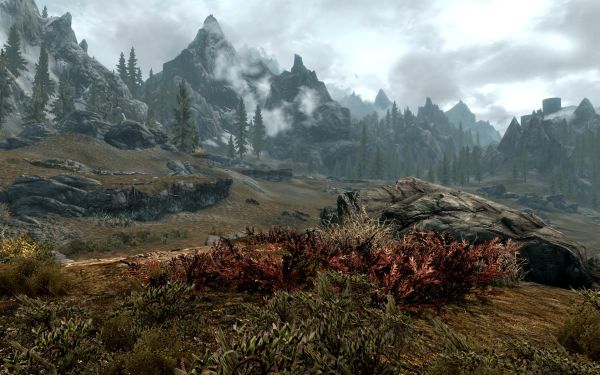
Looks pretty empty, until you look more closely (to the right, on the horizon).
I say that the video game Skyrim was the major inspiration for my current work in progress, working title Oktagonien. But looking at it, I realized that a blurb version would be more likely to compare it to Stephen Donaldson’s Chronicles of Thomas Covenant the Unbeliever, in that the main character is unexpectedly transported from our world (or one nearly identical to it) to a magical world where time flows much faster. In both cases, the possibility is held open that the whole thing may be taking place inside the main character’s head, although it seems increasingly unlikely.
However, the Chronicles were published from 1977 onward, more than a generation after C.S. Lewis’ Chronicles of Narnia. The books are strikingly different in their tone: Chronicles of Narnia are mostly known as children’s books, despite more violence than is common in such books today, or were common before Harry Potter. In contrast, Covenant is a surly misanthrope who rapes the first person who befriends him in the dreamlike world he arrives in, and it takes most of the first three books for him to redeem himself, in so far as that is possible. Saving the world should help somewhat, I guess. Not that I would know.
Yet the Narnia books also featured real-world protagonists being transported to a magical land where time passes very much faster, where magic is common and there are different races of sentient creatures. My main character in Oktagonien is a pretty normal teenager, more similar to the Pevensies than to Thomas Covenant. On the other hand, being alone in the strange world he also lacks the assurance that his world is real, and it does not help that he enters it in a dream at night.
I am not sure if Narnia is the first to use this meme, of people being transported to a magic, fast-moving world. I for one cannot remember any earlier examples, although I’d be happy to hear of any. Given that the tone of my story is a lot less hard-boiled adult than in Covenant, it is just as likely that a blurb would include phrases like “in the tradition of Narnia”.
***
So what about Skyrim? I said that this was my main inspiration. And I think it is. Not in the concept of people from the real world landing in a more fluid (and therefore “lower”) world, I guess. If anything, the Elder Scrolls games and the Ultima games before them may have borrowed from the older fantasy literature.
But what I meant is that I wanted my world to invoke the same feeling as Tamriel of The Elder Scrolls: Â A world that is at first sight somewhat different from ours, but still comprehensible, with a few unusual features but apart from that pretty bland and bare… for the first few minutes. Then, almost incidentally, we find something magic, and rumors of a lost civilization. As time passes, more and more features begin to fill the land: Other races, different types of magic, several lost civilizations one after another leaving artifacts and ruins. Eventually you cannot throw an old book without hitting some hidden remnant of the past, and it becomes evident that the current Iron Age civilization is literally built on top of layers and layers of older civilizations fading back into the dawn of time. And, this is my unique (?) twist on it, all of them created by people like our protagonist.
When playing Skyrim, the world map is pretty bland at the outset. There are a few towns, which you can travel to by renting a horse carriage. Once you’re level 35, as my current character, there are a lot of spots on the map, especially in the parts of the land around the starting area. Â Some are current villages, some are old forts, some are ruins, dungeons or caves. The various points of interest span a period of a few thousand years.
Also in Skyrim (as in earlier games) you start with plain iron or at best steel armor and weapons and very limited magic. As the story progresses, you learn new spells, come across more and more superior materials, and magical items – at first a rare occurrence – become so common you just sell them for cash or store the most powerful in your house for a rainy day. Only a few are better than you can make yourself before breakfast.
My intention is to make Oktagonien even more like this. As the story progresses, we learn of other races, other continents, other historical epochs, other types of magic. It is as if the world has been reinvented again and again, and the current visitor from the Real World has to not just discover these things but somehow find the underlying principle that made them all possible, so that he can harness the basic magic of the world – not primarily to save it, but to save himself.
There is to be no Aslan in Oktagonien. No eternal savior showing up physically at the crucial moment. Rather, the main character – a pretty ordinary teenager – is the only supernatural being currently in the world. But that does not mean the traveler is left orphaned. Luckily there are hints left behind by those who descended from a higher world in ages past. Although they are faded to myth for the common people, their works indistinguishable from myth, the desperate seeker will eventually find the true meaning of the heritage they left behind and be able to continue their work.
That said, it is not really an autobiography.
